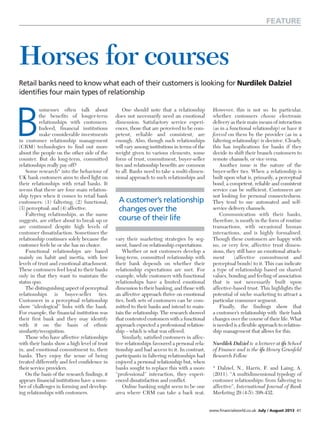
Horses+for+courses
- 1. www.financialworld.co.uk July / August 2013 41 One should note that a relationship does not necessarily need an emotional dimension. Satisfactory service experi- ences, those that are perceived to be com- petent, reliable and consistent, are enough. Also, though such relationships will vary among institutions in terms of the weight given to various elements, some form of trust, commitment, buyer-seller ties and relationship benefits are common to all. Banks need to take a multi-dimen- sional approach to such relationships and vary their marketing strategies by seg- ment, based on relationship expectations. Whether or not customers develop a long-term, committed relationship with their bank depends on whether their relationship expectations are met. For example, while customers with functional relationships have a limited emotional dimension to their banking, and those with an affective approach thrive on emotional ties, both sets of customers can be com- mitted to their banks and intend to main- tain the relationship. The research showed that contented customers with a functional approach expected a professional relation- ship – which is what was offered. Similarly, satisfied customers in affec- tive relationships favoured a personal rela- tionship and had access to it. In contrast, participants in faltering relationships had enjoyed a personal relationship but, when banks sought to replace this with a more “professional” interaction, they experi- enced dissatisfaction and conflict. Online banking might seem to be one area where CRM can take a back seat. However, this is not so. In particular, whether customers choose electronic delivery as their main means of interaction (as in a functional relationship) or have it forced on them by the provider (as in a faltering relationship) is decisive. Clearly, this has implications for banks if they decide to shift their branch customers to remote channels, or vice versa. Another issue is the nature of the buyer-seller ties. When a relationship is built upon what is, primarily, a perceptual bond, a competent, reliable and consistent service can be sufficient. Customers are not looking for personal connectedness. They tend to use automated and self- service delivery channels. Communication with their banks, therefore, is mostly in the form of routine transactions, with occasional human interactions, and is highly formalised. Though these customers are happy with no, or very few, affective trust dimen- sions, they still have an emotional attach- ment (affective commitment and perceptual bonds) to it. This can indicate a type of relationship based on shared values, bonding and feeling of association that is not necessarily built upon affective-based trust. This highlights the potential of niche marketing to attract a particular consumer segment. Finally, the findings show that a customer’s relationship with their bank changes over the course of their life. What is needed is a flexible approach to relation- ship management that allows for this. Nurdilek Dalziel is a lecturer at ifs School of Finance and is the ifs Henry Grunfeld Research Fellow * Dalziel, N., Harris, F. and Laing, A. (2011). “A multidimensional typology of customer relationships: from faltering to affective”, International Journal of Bank Marketing 29 (4-5): 398-432. B usinesses often talk about the benefits of longer-term relationships with customers. Indeed, financial institutions make considerable investments in customer relationship management (CRM) technologies to find out more about the people on the other side of the counter. But do long-term, committed relationships really pay off? Some research* into the behaviour of UK bank customers aims to shed light on their relationships with retail banks. It seems that there are four main relation- ship types when it comes to retail bank customers: (1) faltering; (2) functional; (3) perceptual; and (4) affective. Faltering relationships, as the name suggests, are either about to break up or are continued despite high levels of customer dissatisfaction. Sometimes the relationship continues solely because the customer feels he or she has no choice. Functional relationships are based mainly on habit and inertia, with low levels of trust and emotional attachment. These customers feel loyal to their banks only in that they want to maintain the status quo. The distinguishing aspect of perceptual relationships is buyer-seller ties. Customers in a perceptual relationship show “ideological” links with the bank. For example, the financial institution was their first bank and they may identify with it on the basis of ethnic similarity/recognition. Those who have affective relationships with their banks show a high level of trust in, and emotional commitment to, their banks. They enjoy the sense of being treated differently and feel confidence in their service providers. On the basis of the research findings, it appears financial institutions have a num- ber of challenges in forming and develop- ing relationships with customers. Horses for courses Retail banks need to know what each of their customers is looking for Nurdilek Dalziel identifies four main types of relationship FEATURE A customer’s relationship changes over the course of their life